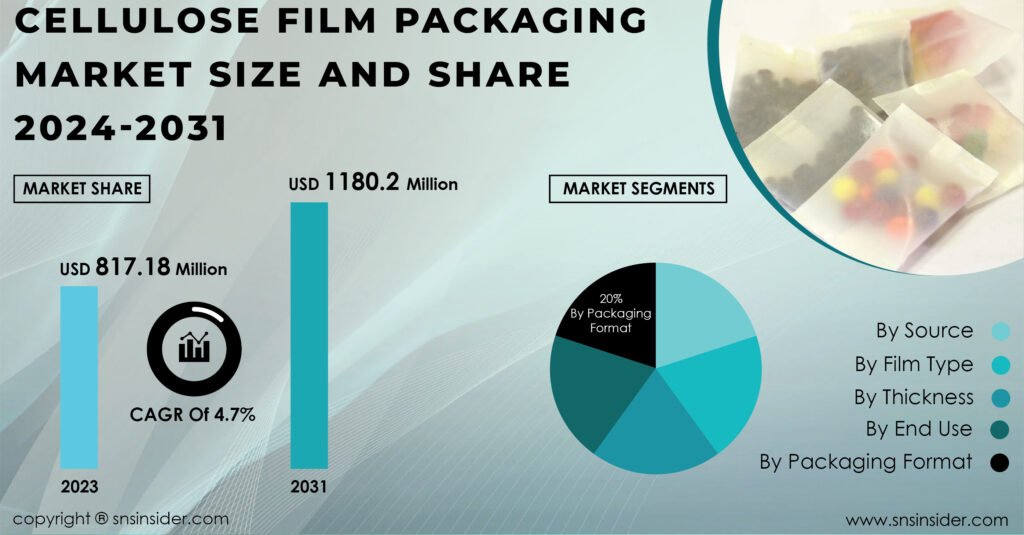
“According to the SNS Insider report, the Cellulose Film Packaging Market Growth was valued at USD 817.18 million in 2023. It is projected to reach USD 1,180.2 million by 2031”
A growing environmentally conscious populace is demanding sustainable packaging solutions.
Cellulose film, derived from wood pulp, offers a biodegradable and compostable alternative to traditional plastics, resonating with these eco-conscious consumers. Secondly, stringent government regulations and corporate sustainability initiatives are further pushing the adoption of cellulose film. These regulations often target single-use plastics, creating a gap that cellulose film can effectively fill. Thirdly, the versatility of cellulose film strengthens its appeal. It supports excellent barrier properties, keeping food fresh and extending shelf life.
Major challenges impacting the market growth:
Cellulose film exhibits weaker mechanical properties compared to traditional plastics. This translates to a higher risk of tearing or puncturing during transportation and handling, potentially leading to product spoilage and increased waste. Studies show rejection rates due to damage during transit for cellulose film can be up to 2-3 times higher than traditional plastics. The cost of cellulose film production is currently higher than traditional plastics.

Cellulose Film Packaging Market
Get a Free Sample PDF Copy of the Latest Research @ https://www.snsinsider.com/sample-request/4140
Major Players Listed in this Report are:
- Futamura Group
- Rotofil Srl
- Sappi Limited
- Rhodia Acetow GmBH
- Eastman Chemical Company
- Tembec Inc
- Celanense Corporation
- Weifang Henglian Cellophane Co Ltd
- Hubei Golden Ring Co Ltd
- Footprint
A 2023 study by SNS Insider revealed that 78% of global respondents prioritize sustainable packaging when making purchasing decisions.
The inherent strength and moisture barrier properties of cellulose film make it suitable for a diverse range of products, from food and beverages to pharmaceuticals and cosmetics. Advancements in production technologies are enabling the creation of high-performance, transparent films with improved printability, further expanding their application potential. For instance, a recent breakthrough allows for the incorporation of antimicrobial properties into cellulose film, enhancing product shelf life and reducing food waste.
The food and beverage segment dominates, accounting for over 35% of the market share.
Here, cellulose film’s breathability is crucial for preserving freshness of fruits, vegetables, and bakery items. Pharmaceutical and personal care sectors, collectively exceeding 20% market share, value cellulose film’s barrier properties for protecting sensitive products from moisture and contamination. In the non-food sector, cellulose film finds use in labels and tapes hold around 15% share due to its excellent printability and resealing properties. The remaining market share is distributed across applications like wrapping films for flowers and tobacco, and release liners in the electronics industry.
Cellulose Film Packaging Market Key Segments:
By Source
- Wood
- Cotton
By Film Type
- Transparent
- Coated
- Colored
- Laminated
By Thickness
- Up to 30 microns
- 31-60 microns
- 61-90 microns
- Above 90 microns
By Packaging Format
- Bags & Pouches
- Labels & Tapes
- Blister Packs
- Wraps & Laminates
- Sachets & Stick Packs
The Cellulose Film Packaging market is witnessing a rise in emerging regions like Asia Pacific and Latin America.
A driving force in this shift is the growing disposable income and rising environmental consciousness in these regions. For instance, a recent study in China indicated a 42% increase in consumer preference for bio-based packaging solutions compared to 2020. This trend is translating into government regulations that favor sustainable alternatives. Latin America is another promising region, with Brazil leading the charge. Here, the rise of the organic food sector is expected to promote the demand for cellulose film packaging for fruits, vegetables, and other perishables
Have Any Query? Ask Our Experts @ https://www.snsinsider.com/enquiry/4140
Competitive Landscape:
Established players like Futamura Chemical, holding its widely recognized NatureFlex brand, and Innovia Films, a prominent producer, hold significant sway. However, this market is not solely their domain.
A wave of regional participants is challenging the status quo, offering competitive pricing and supplying to specific needs. This fragmentation intensifies competition, requiring constant innovation. For instance, Daicel Corporation, a Japanese multinational, is making strides with its bio-based CELFAN RC films.
Futamura’s recent acquisition of Innovia Films underscores the drive for market consolidation. This trend is likely to continue, potentially leading to a more concentrated market structure in the future.
Key Takeaways:
- Consumers are increasingly demanding sustainable alternatives, and cellulose film delivers with its bio-based, compostable nature. This eco-friendly solution is projected to reach a significant value by 2034, reflecting a strong growth path.
- Advancements in cellulose film technology are expanding its capabilities. Improved moisture resistance and heat sealability make it suitable for a wider range of products, particularly in the food and beverage sector.
- This translates to rising adoption in key end-use industries like pharmaceuticals, cosmetics, and consumer goods as well. Stringent regulations on single-use plastics are another tailwind for the market. As governments crack down on traditional plastic packaging, cellulose film emerges as a viable, compliant substitute.
Table of Contents – Key Points
- Introduction
- Research Methodology
- Market Dynamics
- Impact Analysis
- Value Chain Analysis
- Porter’s 5 forces model
- PEST Analysis
- Cellulose Film Packaging Market Segmentation, By Source
- Cellulose Film Packaging Market Segmentation, By Film Type
- Cellulose Film Packaging Market Segmentation, By Thickness
- Cellulose Film Packaging Market Segmentation, By Packaging Format
- Cellulose Film Packaging Market Segmentation, By End Use
- Regional Analysis
- Company Profiles
- Competitive Landscape
- Conclusion
Continue….
Purchase the Latest Version of this Report @ https://www.snsinsider.com/checkout/4140
About Us:
SNS Insider is one of the leading market research and consulting agencies that dominates the market research industry globally. Our company’s aim is to give clients the knowledge they require in order to function in changing circumstances. In order to give you current, accurate market data, consumer insights, and opinions so that you can make decisions with confidence, we employ a variety of techniques, including surveys, video talks, and focus groups around the world.
Contact Us:
Akash Anand – Head of Business Development & Strategy
Phone: +1-415-230-0044 (US)


